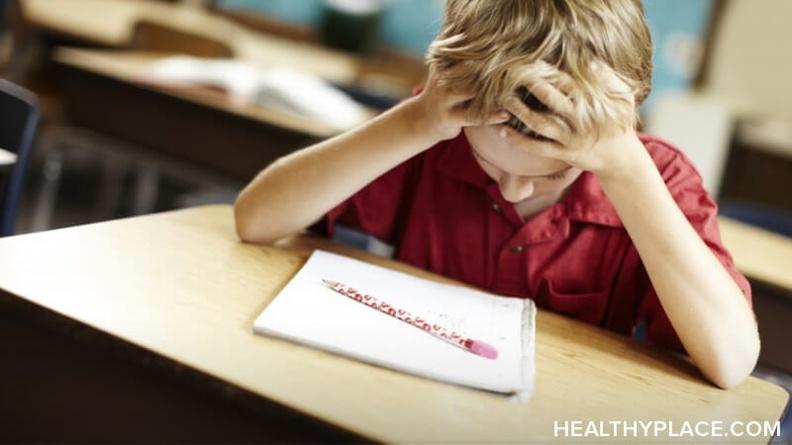How to Help Your Child with Negative Thinking

When children use negative thinking and have a negative self-image, here's how teachers and parents can help them develop emotional and social skills for successful coping.
School is one of the most potent influences upon the social and emotional development of our children. Peer pressures, teacher evaluations, academic challenges, and a host of other forces await our kids every day. These forces shape children's evolving repertoire of life skills in a variety of ways. Sometimes the impact is favorable; for example, warm and healthy friendships can spur the continued growth of empathy, perspective-taking, and mutuality. On the other hand, the potential negative impact of teacher criticism or peer rejection can threaten academic motivation and self-acceptance. While it is reasonable for parents to try to shield youngsters from the negative influences of school, teachers, and guidance counselors are in the best position to do so.
In my role as a child psychologist, I am often in contact with the teachers and school counselors of those children I treat. I try to share my understanding of my patients so as to "lengthen the shelf life" of therapeutic intervention. Often there are certain school requirements and triggers that children do not possess adequate skills to manage, i.e., sharing attention, complying with rules, containing energy, accepting critical feedback, being the object of teasing, etc. Teachers and counselors are eager to help and receptive to my suggestions for school-based intervention. When I explain my coaching model and Parent Coaching Cards, they invariably ask how such coaching might be implemented in the school. This article will discuss one of the major points that I have offered in response to this question.
How Internal Language Reflects a Child's Negative Thoughts
The overriding goal of my work with all children, and ADHD kids in particular, is to teach them emotional and social skills for successful coping. My coaching model leans heavily upon empowering one's "thinking side" and strengthening one's watch over the "reacting side. One critical way this is accomplished is through the development of constructive internal language: an internal language without negative thinking. Internal language is what we silently think to ourselves. It takes on a constructive quality when it is used in the service of coping with life demands.
Unfortunately, many children are more accustomed to using internal language as a release valve when faced with challenges, rather than as a pathway to effectively contend with the challenge. For example, when various school pressures build up, students are more likely to think or say to themselves, "this is awful...I can't do this...I'll never make a friend, etc." These negative thinking internal statements may temporarily relieve pressure by projecting responsibility and forfeiting participation. But, in the long run, they just perpetuate problems by drawing a child away from the construction of solutions.
Changing a Child's Negative Thinking to Positive Thinking
Children can be coached in how to use their internal language in all phases of emotional and social skill-building. The school is the ideal place to conduct such coaching due to the presence of demands and the support of teachers and counselors. One of the first steps is to help children identify their constructive internal language. It may be referred to as their "helpful thinking voice" to distinguish it from some of the self-defeating thinking that goes on in children's minds. Teachers or counselors might explain that the "thinking voice" helps to solve problems and make good decisions while the "unhelpful voice" can actually make problems worse or lead to bad decisions. An example can make this clear:
Suppose a boy sat down to do his worksheet of ten problems and realized that he could not do three problems on the page. Two thoughts come to mind:
A. "This is impossible, I'll never get a good mark on this. Why even bother trying?"
B. "Well, just because I can't do these three doesn't mean I shouldn't try my best."
"A" can be characterized as the "unhelpful voice" and "B" as the "helpful thinking voice."
Next, children might be presented with the following dichotomy to reinforce their understanding: Examples of the Mind's Two Voices
1. In Response To Academic Challenge
Helpful Thinking Voice:
"This looks hard and probably even too hard for me to do... but I'll never know unless I try. I'm going to take it step by step and just forget about how hard it is so I can keep trying."
Unhelpful Voice:
"This looks hard and probably even too hard for me to do...I'm definitely not going to be able to it. I hate this stuff and can't see why we have to learn it."
2. In Response to Social Challenge
Helpful Thinking Voice:
"They don't like me and I don't like the way they are treating me. Maybe I'm different from them and they can't deal with that. Or, maybe they just don't really know me yet, and they'll change their minds when they get to know me better."
Unhelpful Voice:
"They don't like me and I don't like the way they are treating me. They're idiots and I feel like smashing them. If they say one more mean thing to me, I'm definitely going to make them pay for what they're doing to me."
3. In Response to Emotional Challenge
Helpful Thinking Voice:
"Things didn't work out...again. This is getting really frustrating. It's hard to understand why it's happened to me this time. Maybe somebody else can help me figure it out. Who should I ask?"
Unhelpful Voice:
"Things didn't work out...again. Why does this always happen? This is so unfair. I can't believe it. I don't deserve it. Why me?"
Most children will recognize how in each example, the initial thoughts are identical, but the resulting internal dialogue is completely contrary. The discussion then focuses on the imaginary scenarios that might lead to each one of these examples, and the specific phrases that each voice utilizes. In the case of the helpful thinking voice, words and phrases such as "step by step," " maybe" and "hard to understand" are offered to stress the importance of plotting a strategy to cope, making the option of change seem viable, and expressing the quest to make sense out of circumstances. In contrast, words and phrases such as "definitely," "hate," idiots," "feel like smashing them," "always," and "unfair" reveal the emotionally charged and absolute thinking of the unhelpful voice.
The helpful thinking voice examples also demonstrate the attempt to construct solutions to the problems faced by the child in question. In the academic challenge, the child adopts a strategy of minimizing awareness of difficulty. In the social challenge, the child adopts the perception of things changing for the better in the future. In the emotional challenge, the child decides to pursue helpful consultation.
Once children grasp the importance of constructive internal language, they will be better able to benefit from the school-based coaching of social and emotional skills. Future articles will address the next steps in that progression.
APA Reference
Richfield, S.
(2019, August 5). How to Help Your Child with Negative Thinking, HealthyPlace. Retrieved
on 2025, December 31 from https://www.healthyplace.com/parenting/the-parent-coach/how-to-help-children-with-negative-thinking


